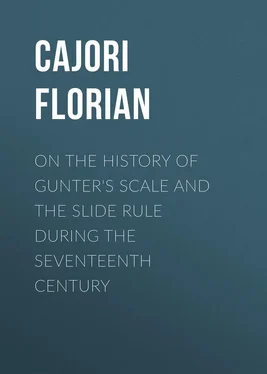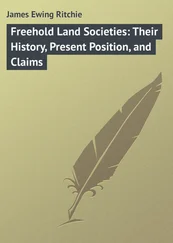Florian Cajori - On the History of Gunter's Scale and the Slide Rule during the Seventeenth Century
Здесь есть возможность читать онлайн «Florian Cajori - On the History of Gunter's Scale and the Slide Rule during the Seventeenth Century» — ознакомительный отрывок электронной книги совершенно бесплатно, а после прочтения отрывка купить полную версию. В некоторых случаях можно слушать аудио, скачать через торрент в формате fb2 и присутствует краткое содержание. ISBN: , Издательство: Иностранный паблик, Жанр: foreign_antique, foreign_prose, на английском языке. Описание произведения, (предисловие) а так же отзывы посетителей доступны на портале библиотеки ЛибКат.
- Название:On the History of Gunter's Scale and the Slide Rule during the Seventeenth Century
- Автор:
- Издательство:Иностранный паблик
- Жанр:
- Год:неизвестен
- ISBN:http://www.gutenberg.org/ebooks/42216
- Рейтинг книги:4 / 5. Голосов: 1
-
Избранное:Добавить в избранное
- Отзывы:
-
Ваша оценка:
- 80
- 1
- 2
- 3
- 4
- 5
On the History of Gunter's Scale and the Slide Rule during the Seventeenth Century: краткое содержание, описание и аннотация
Предлагаем к чтению аннотацию, описание, краткое содержание или предисловие (зависит от того, что написал сам автор книги «On the History of Gunter's Scale and the Slide Rule during the Seventeenth Century»). Если вы не нашли необходимую информацию о книге — напишите в комментариях, мы постараемся отыскать её.
On the History of Gunter's Scale and the Slide Rule during the Seventeenth Century — читать онлайн ознакомительный отрывок
Ниже представлен текст книги, разбитый по страницам. Система сохранения места последней прочитанной страницы, позволяет с удобством читать онлайн бесплатно книгу «On the History of Gunter's Scale and the Slide Rule during the Seventeenth Century», без необходимости каждый раз заново искать на чём Вы остановились. Поставьте закладку, и сможете в любой момент перейти на страницу, на которой закончили чтение.
Интервал:
Закладка:
The same remark applies to William Leybourn who, after speaking of Seth Partridge’s slide rule, returns to forms of Gunter’s scale, saying: 14 14 William Leybourn, op. cit. , pp. 129, 130, 132, 133.
There is yet another way of disposing of this Line of Proportion, by having one Line of the full length of the Ruler, and another Line of the same Radius broken in two parts between 3 and 4; so that in working your Compasses never go off of the Line: This is one of the best contrivances, but here Compasses must be used. These are all the Contrivances that I have hitherto seen of these Lines: That which I here speak of, and will shew how to use, is only two Lines of one and the same Radius, being set upon a plain Ruler of any length (the larger the better) having the beginning of one Line, at the end of the other, the divisions of each Line being set so close together, that if you find any number upon one of the Lines, you may easily see what number stands against it on the other Line. This is all the Variation..
Example 1. If a Board be 1 Foot 64 parts broad, how much in length of that Board will make a Foot Square? Look upon one of your Lines (it matters not which) for 1 Foot 64 parts, and right against it on the other Line you shall find 61; and so many parts of a Foot will make a Foot square of that Board.
This contrivance solves the equation 1.64 x =1, yielding centesimal parts of a foot.
James Atkinson 15 15 James Atkinson’s edition of Andrew Wakely’s The Mariners Compass Rectified , London, 1694 [Wakely’s preface dated 1664, Atkinson’s preface, 1693]. Atkinson adds An Appendix containing Use of Instruments most useful in Navigation . Our quotation is from this Appendix , p. 199.
speaks of “Gunter’s scale” as “usually of Boxwood.. commonly 2 ft. long, 1½ inch broad” and “of two kinds: long Gunter or single Gunter , and the sliding Gunter . It appears that during the seventeenth century (and long after) the Gunter’s scale was a rival of the slide rule.
III. RICHARD DELAMAIN’S GRAMMELOGIA
We begin with a brief statement of the relations between Oughtred and Delamain. At one time Delamain, a teacher of mathematics in London, was assisted by Oughtred in his mathematical studies. In 1630 Delamain published the Grammelogia , a pamphlet describing a circular slide rule and its use. In 1631 he published another tract, on the Horizontall Quadrant . 16 16 R. Delamain, The Making, Description, and Use of a small portable Instrument.. called a Horizontall Quadrant , etc., London, 1631.
In 1632 appeared Oughtred’s Circles of Proportion 17 17 Oughtred’s description of his circular slide rule of 1632 and his rectilinear slide rule of 1633, as well as a drawing of the circular slide rule, are reproduced in Cajori’s History of the Slide Rule , Addenda, pp. ii-vi.
translated into English from Oughtred’s Latin manuscript by another pupil, William Forster, in the preface of which Forster makes the charge (without naming Delamain) that “another.. went about to pre-ocupate” the new invention. This led to verbal disputes and to the publication by Delamain of several additions to the Grammelogia , describing further designs of circular slide rules and also stating his side of the bitter controversy, but without giving the name of his antagonist. Oughtred’s Epistle was published as a reply. Each combatant accuses the other of stealing the invention of the circular slide rule and the horizontal quadrant.
There are at least five different editions, or impressions, of the Grammelogia which we designate, for convenience, as follows:
Grammelogia I , 1630. One copy in the Cambridge University Library. 18 18 The full title of the Grammelogia I is as follows: Gram̄elogia | or, | The Mathematicall Ring. | Shewing (any reasonable Capacity that hath | not Arithmeticke) how to resolve and worke | all ordinary operations of Arithmeticke. | And those which are most difficult with greatest | facilitie: The extraction of Roots, the valuation of | Leases, &c. The measuring of Plaines | and Solids. | With the resolution of Plaine and Sphericall | Triangles. | And that onely by an Ocular Inspection, | and a Circular Motion. | Naturae secreta tempus aperit. | London printed by John Haviland, 1630.
Grammelogia II , I have not seen a copy of this.
Grammelogia III , One copy in the Cambridge University Library. 19 19 Grammelogia III is the same as Grammelogia I , except for the addition of an appendix, entitled: De la Mains | Appendix | Vpon his | Mathematicall | Ring. Attribuit nullo (praescripto tempore) vitae | vsuram nobis ingeniique Deus. | London, | .. The next line or two of this title-page which probably contained the date of publication, were cut off by the binder in trimming the edges of this and several other pamphlets for binding into one volume.
Grammelogia IV , One copy in the British Museum, another in the Bodleian Library, Oxford. 20 20 Grammelogia IV has two title pages. The first is Mirifica Logarithmoru’ Projectio Circularis . There follows a diagram of a circular slide rule, with the inscription within the innermost ring: Nil Finis, Motvs, Circvlvs vllvs Habet . The second title page is as follows: Grammelogia | Or, the Mathematicall Ring. | Extracted from the Logarythmes, and projected Circular: Now published in the | inlargement thereof unto any magnitude fit for use: shewing any reason- | able capacity that hath not Arithmeticke how to resolve and worke, | all ordinary operations of Arithmeticke: | And those that are most difficult with greatest facilitie, the extracti- | on of Rootes, the valuation of Leases, &c. the measuring of Plaines and Solids, | with the resolution of Plaine and Sphericall Triangles applied to the | Practicall parts of Geometrie, Horologographie, Geographie | Fortification, Navigation, Astronomie, &c. | And that onely by an ocular inspection, and a Circular motion, Invented and first published, by R. Delamain, Teacher, and Student of the Mathematicks. | Naturae secreta tempus aperit. | There is no date. There follows the diagram of a second circular slide rule, with the inscription within the innermost ring: Typus proiectionis Annuli adaucti vt in Conslusione Lybri praelo commissi, Anno 1630 promisi . There are numerous drawings in the Grammelogia , all of which, excepting the drawings of slide rules on the engraved title-pages of Grammelogia IV and V , were printed upon separate pieces of paper and then inserted by hand into the vacant spaces on the printed pages reserved for them. Some drawings are missing, so that the Bodleian Grammelogia IV differs in this respect slightly from the copy in the British Museum and from the British Museum copy of Grammelogia V .
Grammelogia V , One copy in the British Museum.
In Grammelogia I the first three leaves and the last leaf are without pagination. The first leaf contains the title-page; the second leaf, the dedication to the King and the preface “To the Reader;” the third leaf, the description of the Mathematical Ring. Then follow 22 numbered pages. Counting the unnumbered pages, there are altogether 30 pages in the pamphlet. Only the first three leaves of this pamphlet are omitted in Grammelogia IV and V .
In Grammelogia III the Appendix begins with a page numbered 52 and bears the heading “Conclusion;” it ends with page 68, which contains the same two poems on the mathematical ring that are given on the last page of Grammelogia I but differs slightly in the spelling of some of the words. The 51 pages which must originally have preceded page 52, we have not seen. The edition containing these we have designated Grammelogia II . The reason for the omission of these 51 pages can only be conjectured. In Oughtred’s Epistle (p. 24), it is stated that Delamain had given a copy of the Grammelogia to Thomas Brown, and that two days later Delamain asked for the return of the copy, “because he had found some things to be altered therein” and “rent out all the middle part.” Delamain labored “to recall all the bookes he had given forth, (which were many) before the sight of Brownes Lines .” These spiral lines Oughtred claimed that Delamain had stolen from Brown. The title-page and page 52 are the only parts of the Appendix , as given in Grammelogia III , that are missing in the Grammelogia IV and V .
Читать дальшеИнтервал:
Закладка:
Похожие книги на «On the History of Gunter's Scale and the Slide Rule during the Seventeenth Century»
Представляем Вашему вниманию похожие книги на «On the History of Gunter's Scale and the Slide Rule during the Seventeenth Century» списком для выбора. Мы отобрали схожую по названию и смыслу литературу в надежде предоставить читателям больше вариантов отыскать новые, интересные, ещё непрочитанные произведения.
Обсуждение, отзывы о книге «On the History of Gunter's Scale and the Slide Rule during the Seventeenth Century» и просто собственные мнения читателей. Оставьте ваши комментарии, напишите, что Вы думаете о произведении, его смысле или главных героях. Укажите что конкретно понравилось, а что нет, и почему Вы так считаете.












